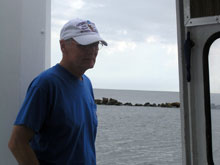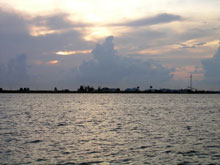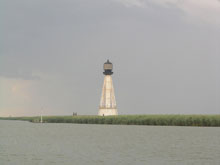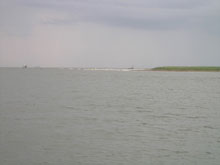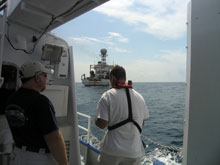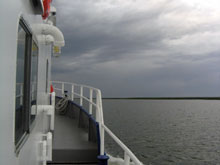
A view from aboard the Acadiana as it cruises down the Mississippi channel. Click image for larger view and image credit.
Harry Roberts, a geologist at Louisiana State University, enjoys the ride. Click image for larger view and image credit.
Leg II: We’re On Our Way!
September 5, 2009
Lori Johnston
Harry Roberts
Louisiana State University
Sheli Smith, PhD
PAST Foundation
And so it begins . . . the adventure, the journey, the quest for answers. It all sounds very exciting, which it is on a number of different levels, for many different people.
People take journeys every day: some are short; some are long. Sometimes we get to see things we have never seen before; other times we go places that are familiar but we look at the sights with new eyes. This is the journey of a group of archaeologists, biologists, and geologists to look at five shipwrecks at great depth.
It is the second half of a research trip that started in August and initially focused solely on biological specimens, specifically Lophelia. (Lophelia is a type of coral, which can be a vital foundation species to the health of the oceans.) Now, during the second part of the project, five of the selected sites will be shipwrecks that should provide both cultural and natural resource information.
We left the dock at Venice, Louisiana, at 6 a.m. aboard the crew transport vessel Acadiana. After spending the night at the marina, we found the cruise down the river to the Gulf of Mexico to be an amazing trip. It took over six hours to reach the research vessel Ronald H. Brown, which was waiting to exchange crews in deeper water off the coast. Cruising down the Southern Channel, Harry Roberts, a geologist at Louisiana State University, took the time to guide us through the geologic formation of the delta.
“In geologic time, the Delta, specifically the Bird Foot Delta, is new— less than 1,000 years old,” Dr. Roberts pointed out. On a map that showed the other routes the Mississippi River took to the sea in the past, Roberts guided us through a lesson in silt deposition and history, all rolled into one.
“See that lighthouse? It used to be at the mouth of the river; now it is a quarter mile up the river,” he noted. As we crossed the bar to the Gulf, we could see where a beach had existed at the mouth of the channel, prior to Hurricane Katrina.
The trip out to the Ron Brown was a bit bumpy, as the Acadiana tended to roll not just back and forth, but side to side. Sometimes it felt like it was moving all over the place. The captain and first mate were so good to us, supplying coffee, muffins, cakes, and fruit. If anything, we won’t starve.
The water of the Gulf was calm enough for the Acadiana to pull alongside the Ron Brown and off-load gear and crew without too much difficulty. Our new vessel was bigger and "badder," which will make our stay just that much more comfy! As interesting as the ride out was, we begin the real work tonight. Deployment of the remotely operated vehicle (ROV) Jason II hit the water at 20:00hrs. We are all very excited to begin our work tonight. Stay tuned, as we are sure to get some amazing pictures of the first wreck and to see some great critters to go with it!




























